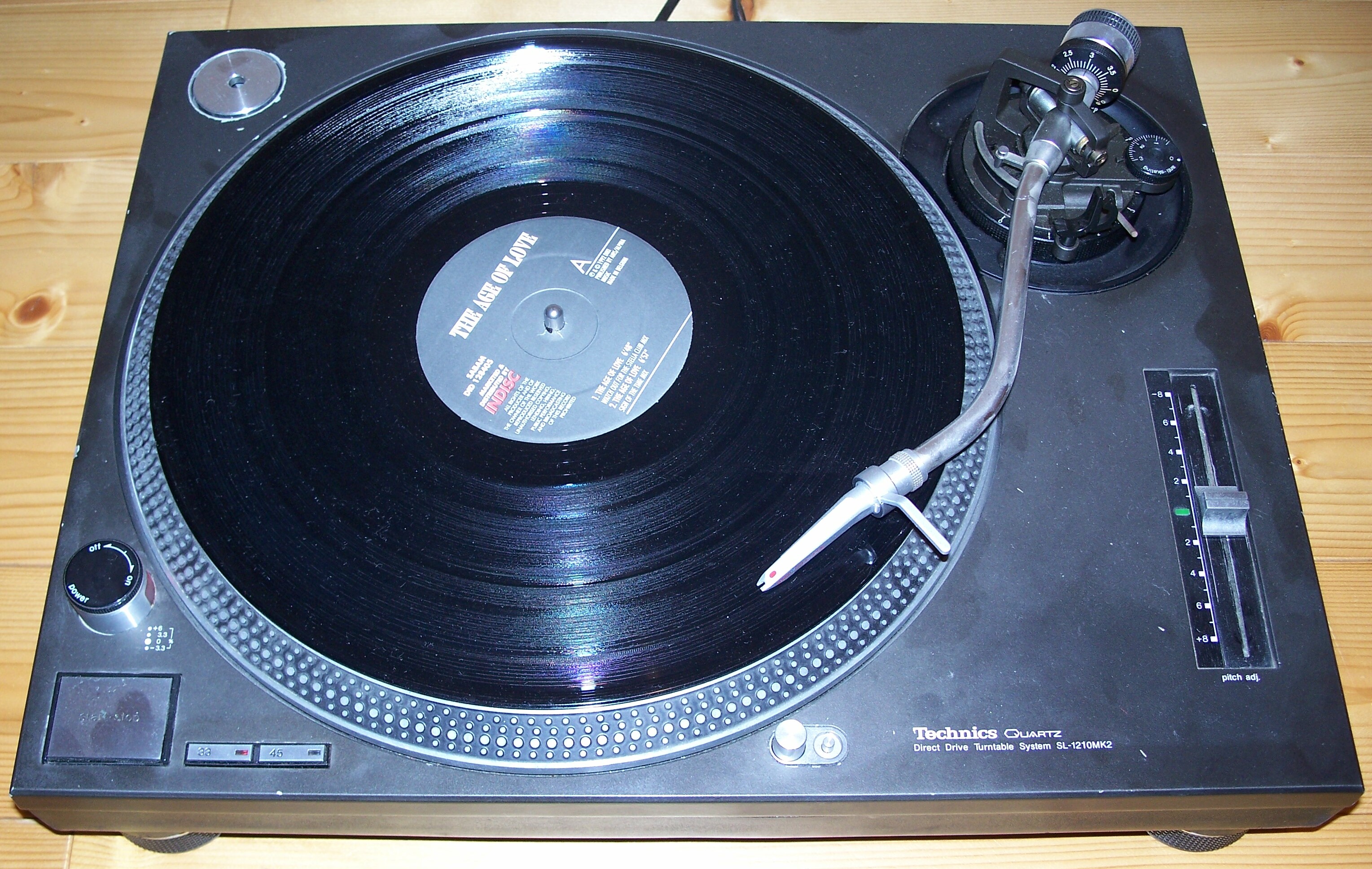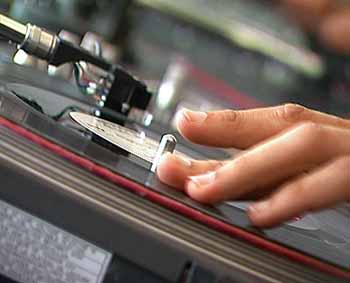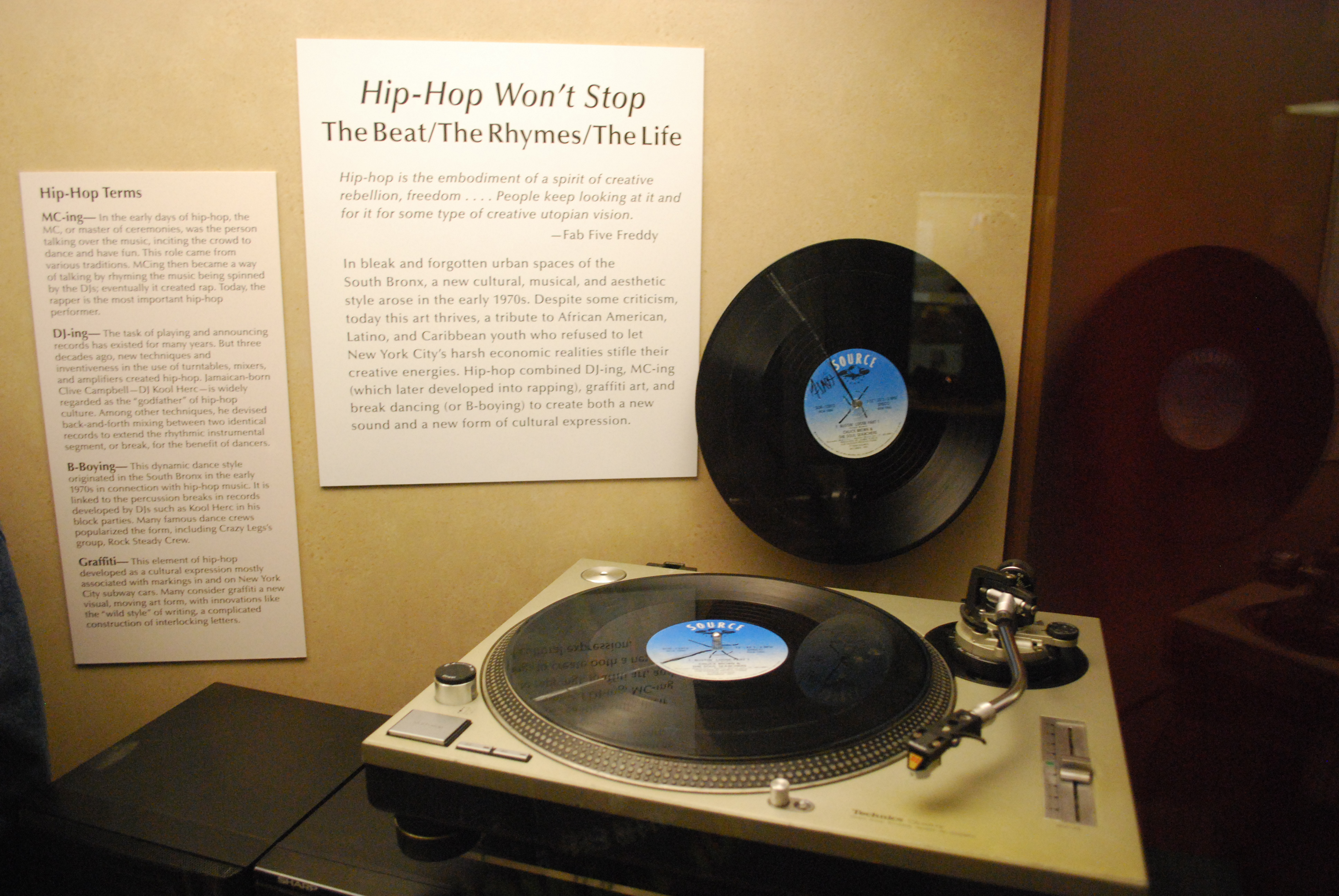|
Slipmat
A slipmat is a circular piece of slippery cloth or synthetic materials disk jockeys place on the turntable platter instead of the traditional rubber mat. Unlike the rubber mat which is made to hold the record firmly in sync with the rotating platter, slipmats are designed to slip on the platter, allowing the DJ to manipulate a record on a turntable while the platter continues to rotate underneath. This is useful for holding a record still for slip-cueing, making minute adjustments during beatmatching and mixing and pulling the record back and forth for scratching Scratching, sometimes referred to as scrubbing, is a DJ and turntablist technique of moving a vinyl record back and forth on a turntable to produce percussive or rhythmic sounds. A crossfader on a DJ mixer may be used to fade between two record .... They are also very commonly used simply as decoration for when a record isn't on the turntable. The slipmat was invented by hip-hop pioneer Grandmaster Flash to im ... [...More Info...] [...Related Items...] OR: [Wikipedia] [Google] [Baidu] |
Disk Jockey
A disc jockey, more commonly abbreviated as DJ, is a person who plays recorded music for an audience. Types of DJs include radio DJs (who host programs on music radio stations), club DJs (who work at a nightclub or music festival), mobile DJs (who are hired to work at public and private events such as weddings, parties, or festivals), and turntablists (who use record players, usually turntables, to manipulate sounds on phonograph records). Originally, the "disc" in "disc jockey" referred to shellac and later vinyl records, but nowadays DJ is used as an all-encompassing term to also describe persons who mix music from other recording media such as cassettes, CDs or digital audio files on a CDJ, controller, or even a laptop. DJs may adopt the title "DJ" in front of their real names, adopted pseudonyms, or stage names. DJs commonly use audio equipment that can play at least two sources of recorded music simultaneously. This enables them to blend tracks together to crea ... [...More Info...] [...Related Items...] OR: [Wikipedia] [Google] [Baidu] |
Slip-cueing
Slip-cueing is a turntable-based DJ technique which consists of holding a record still while the platter rotates underneath the slipmat and releasing it at the right moment. In this way the record attains the right speed almost immediately, with no need to wait for the heavy platter to accelerate. Slip-cueing was introduced to the disco scene by Francis Grasso Francis Grasso (March 25, 1949 – March 20, 2001) was an American disco music disc jockey from New York City, best known for inventing the technique of beatmatching (sometimes referred to as mixing or blending) which is the foundation of the mod ..., but the technique had been used for many years in the radio broadcast industry; it was often used by radio stations to match a following song to the preceding song, preserving the beat. Grasso used this method to great effect in order to create a continuous flow of music for a nightclub dance floor. See also * Beatmatching Sources *Jones, Alan and Kantonen, Jussi (1999). ... [...More Info...] [...Related Items...] OR: [Wikipedia] [Google] [Baidu] |
Technics SL-1210Mk2
{{disambiguation ...
Technic or Technics may refer to: * Technics (brand), a brand name of the Panasonic Corporation * Technics (law), a legal concept * Engineering * Lego Technic, toy * An anglicization (with subtle variation) of the Ancient Greek term techne, used primarily in media theory See also * Technical (other) * Technology Technology is the application of knowledge to reach practical goals in a specifiable and Reproducibility, reproducible way. The word ''technology'' may also mean the product of such an endeavor. The use of technology is widely prevalent in me ... [...More Info...] [...Related Items...] OR: [Wikipedia] [Google] [Baidu] |
Phonograph
A phonograph, in its later forms also called a gramophone (as a trademark since 1887, as a generic name in the UK since 1910) or since the 1940s called a record player, or more recently a turntable, is a device for the mechanical and analogue recording and reproduction of sound. The sound vibration waveforms are recorded as corresponding physical deviations of a spiral groove engraved, etched, incised, or impressed into the surface of a rotating cylinder or disc, called a "record". To recreate the sound, the surface is similarly rotated while a playback stylus traces the groove and is therefore vibrated by it, very faintly reproducing the recorded sound. In early acoustic phonographs, the stylus vibrated a diaphragm which produced sound waves which were coupled to the open air through a flaring horn, or directly to the listener's ears through stethoscope-type earphones. The phonograph was invented in 1877 by Thomas Edison. Alexander Graham Bell's Volta Laboratory made sev ... [...More Info...] [...Related Items...] OR: [Wikipedia] [Google] [Baidu] |
Platter (turntable)
Platter may refer to: * ''Platter'' (album), by Jock Cheese * Platter (dinner), a meal of several components served together on a platter or in a basket *Platter (dishware), large dish used for serving food * Platter (horse), American Champion racehorse * Platter, Oklahoma, U.S. *Hard disk drive platter, part of a computer hard drive *A platter lift, a mechanized system for pulling skiers and snowboarders uphill *The Platters, an American vocal group People with the surname *Bruno Platter (1944–), Grand master of the Teutonic Order * Luanne Platter, fictional character in the animated series ''King of the Hill'' *Thomas Platter (1499–1582), humanist scholar and writer *Thomas Platter the Younger Thomas Platter the Younger (; ; c. 24 July 1574 in Basel – 4 December 1628 in Basel) was a Swiss-born physician, traveller and diarist, the son of the humanist Thomas Platter the Elder. The foremost record of Platter's life is the manuscript ... (c.1574 – 1628), Swiss-born phy ... [...More Info...] [...Related Items...] OR: [Wikipedia] [Google] [Baidu] |
Gramophone Record
A phonograph record (also known as a gramophone record, especially in British English), or simply a record, is an analog sound storage medium in the form of a flat disc with an inscribed, modulated spiral groove. The groove usually starts near the periphery and ends near the center of the disc. At first, the discs were commonly made from shellac, with earlier records having a fine abrasive filler mixed in. Starting in the 1940s polyvinyl chloride became common, hence the name vinyl. The phonograph record was the primary medium used for music reproduction throughout the 20th century. It had co-existed with the phonograph cylinder from the late 1880s and had effectively superseded it by around 1912. Records retained the largest market share even when new formats such as the compact cassette were mass-marketed. By the 1980s, digital media, in the form of the compact disc, had gained a larger market share, and the record left the mainstream in 1991. Since the 1990s, records ... [...More Info...] [...Related Items...] OR: [Wikipedia] [Google] [Baidu] |
Phonograph
A phonograph, in its later forms also called a gramophone (as a trademark since 1887, as a generic name in the UK since 1910) or since the 1940s called a record player, or more recently a turntable, is a device for the mechanical and analogue recording and reproduction of sound. The sound vibration waveforms are recorded as corresponding physical deviations of a spiral groove engraved, etched, incised, or impressed into the surface of a rotating cylinder or disc, called a "record". To recreate the sound, the surface is similarly rotated while a playback stylus traces the groove and is therefore vibrated by it, very faintly reproducing the recorded sound. In early acoustic phonographs, the stylus vibrated a diaphragm which produced sound waves which were coupled to the open air through a flaring horn, or directly to the listener's ears through stethoscope-type earphones. The phonograph was invented in 1877 by Thomas Edison. Alexander Graham Bell's Volta Laboratory made sev ... [...More Info...] [...Related Items...] OR: [Wikipedia] [Google] [Baidu] |
Beatmatching
Beatmatching or pitch cue is a disc jockey technique of pitch shifting or timestretching an upcoming track to match its tempo to that of the currently playing track, and to adjust them such that the beats (and, usually, the bars) are synchronized—e.g. the kicks and snares in two house records hit at the same time when both records are played simultaneously. Beatmatching is a component of beatmixing which employs beatmatching combined with equalization, attention to phrasing and track selection in an attempt to make a single mix that flows together and has a good structure. The technique was developed to keep the people from leaving the dancefloor at the end of the song. These days it is considered basic among disc jockeys (DJs) in electronic dance music genres, and it is standard practice in clubs to keep the constant beat through the night, even if DJs change in the middle. Beatmatching is no longer considered a novelty, and new digital software has made the technique muc ... [...More Info...] [...Related Items...] OR: [Wikipedia] [Google] [Baidu] |
Scratching
Scratching, sometimes referred to as scrubbing, is a DJ and turntablist technique of moving a vinyl record back and forth on a turntable to produce percussive or rhythmic sounds. A crossfader on a DJ mixer may be used to fade between two records simultaneously. While scratching is most associated with hip hop music, where it emerged in the mid-1970s, from the 1990s it has been used in some styles of rap rock, rap metal and nu metal. In hip hop culture, scratching is one of the measures of a DJ's skills. DJs compete in scratching competitions at the DMC World DJ Championships and IDA (International DJ Association), formerly known as ITF (International Turntablist Federation). At scratching competitions, DJs can use only scratch-oriented gear (turntables, DJ mixer, digital vinyl systems or vinyl records only). In recorded hip hop songs, scratched "hooks" often use portions of other songs. History Precursors A rudimentary form of turntable manipulation that is related to scr ... [...More Info...] [...Related Items...] OR: [Wikipedia] [Google] [Baidu] |
Grandmaster Flash
Joseph Saddler (born January 1, 1958), popularly known by his stage name Grandmaster Flash, is an American DJ and rapper. He is considered to be one of the pioneers of Hip Hop DJing, cutting, scratching and mixing. Grandmaster Flash and the Furious Five were inducted into the Rock and Roll Hall of Fame in 2007, becoming the first Hip Hop act to be honored. In 2019 he won the Polar Music Prize. On May 21, 2022, he acquired an honorary doctorate in Fine Arts from Buffalo State College. Early life, family and education Saddler's family immigrated to the United States from Barbados. He was raised in the Bronx, New York City, where he attended Samuel Gompers High School, a public vocational school. There, he learned how to repair electronic equipment. Saddler's parents played an important role in his interest in music. His father was a fan of Caribbean and African American recordings. During his childhood, Joseph Saddler was fascinated by his father's record collection. In an ... [...More Info...] [...Related Items...] OR: [Wikipedia] [Google] [Baidu] |
The Washington Post
''The Washington Post'' (also known as the ''Post'' and, informally, ''WaPo'') is an American daily newspaper published in Washington, D.C. It is the most widely circulated newspaper within the Washington metropolitan area and has a large national audience. Daily broadsheet editions are printed for D.C., Maryland, and Virginia. The ''Post'' was founded in 1877. In its early years, it went through several owners and struggled both financially and editorially. Financier Eugene Meyer (financier), Eugene Meyer purchased it out of bankruptcy in 1933 and revived its health and reputation, work continued by his successors Katharine Graham, Katharine and Phil Graham (Meyer's daughter and son-in-law), who bought out several rival publications. The ''Post'' 1971 printing of the Pentagon Papers helped spur opposition to the Vietnam War. Subsequently, in the best-known episode in the newspaper's history, reporters Bob Woodward and Carl Bernstein led the American press's investigation into ... [...More Info...] [...Related Items...] OR: [Wikipedia] [Google] [Baidu] |



.jpg)


